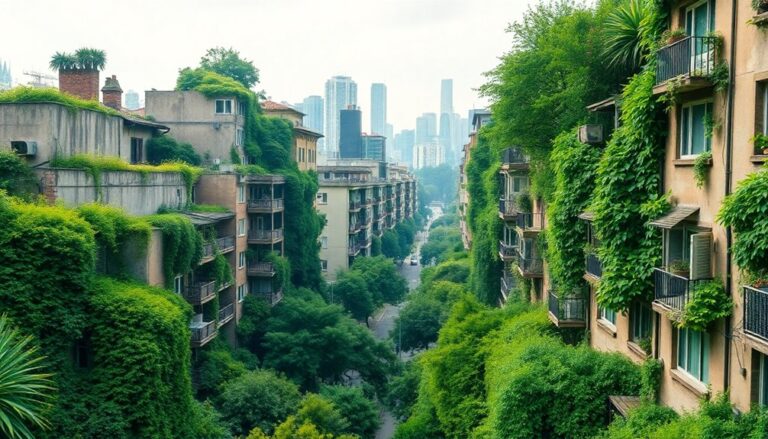In a world without humans, nature flourishes, reclaiming urban areas and restoring ecosystems. Clear skies replace smog, and wildlife thrives without human interference. You'll see small animals scavenging and larger ones roaming freely, altering predator-prey dynamics. Infrastructure deteriorates quickly, with buildings crumbling and landscapes transforming into lush habitats. Over time, ecosystems recover, becoming more balanced and diverse. However, the loss of human culture and knowledge presents a stark contrast to this vibrant revival. The future of Earth's ecosystems will highlight nature's adaptability and resilience. There's much more to explore about this enchanting transformation.
Essential Insights
- Air quality would improve significantly, leading to clearer skies as pollution levels decline rapidly.
- Ecosystems would thrive, with increased biodiversity and natural processes restoring soil quality and nutrient cycling.
- Infrastructure would deteriorate, leaving behind reminders of human civilization amidst urban decay.
- Wildlife populations would flourish, leading to significant changes in predator-prey dynamics and migratory patterns.
- Cultural heritage would fade, risking the loss of traditional knowledge and practices essential for community resilience.
Immediate Effects of Human Absence

In just a matter of days, the world would undergo dramatic transformations in the absence of humans. You'd notice the air becoming clearer and the sky bluer, free from the smog and dust that once choked urban landscapes. Rain and wind would scrub the Earth's surface, washing away human-made pollutants, while nature would quickly begin reclaiming urban spaces. Seeds would sprout in cracked pavements, and before long, you'd witness a shift toward feral survival as wildlife flourishes in the void left behind.
As urban areas transform, urban silence would reign. The absence of human noise would create an eerie calm where previously bustling streets echoed with life. Smaller animals like raccoons and skunks would scavenge through empty neighborhoods, while larger creatures like deer and coyotes would venture into city parks. Meanwhile, domesticated animals would struggle to adapt, becoming feral or falling prey to their wild counterparts.
However, it's not just wildlife that would experience these changes. Subways would flood within just 36 hours, while water systems would fail, causing pipes to freeze and burst during winter. Without maintenance, power plants would shut down, plunging cities into darkness. Additionally, structural corrosion from underground water would lead to pavement and bridge collapses, further complicating the urban landscape.
As the immediate effects of human absence unfold, you'd witness an ecosystem reshaping itself, battling invasive species for dominance while nature reclaims its territory. The world would be a quieter, wilder place, but not without its challenges as it navigates this new reality.
Infrastructure Deterioration Over Time

Within weeks of human absence, infrastructure begins to crumble, revealing the vulnerability of buildings and structures. Modern glass and metal designs shatter and rust, while stone structures, though more resilient, start to soften over time. Windows fall from rotting frames, creating openings for wildlife to reclaim urban spaces. Without heating and air conditioning, mold proliferates, and frozen pipes burst, accelerating the decay.
Transportation systems face similar fates. Subway tunnels flood within days, overwhelmed by rainwater and rising groundwater. Roads and pavements crack, providing fertile ground for seeds, allowing trees to emerge amidst urban decay. Bridges, straining under the weight of saplings taking root, risk structural failures. Meanwhile, vehicles decay, leaving once-bustling highways and motorways to be overrun by vegetation.
Public utilities, too, fall into disrepair. The electricity grid collapses as fuel runs out, while unchecked glitches at oil refineries and nuclear plants threaten catastrophic failures. Water infrastructure corrodes, transforming streets into mid-city rivers. With public transportation systems rendered inoperative, urban mobility plummets.
Over time, the lack of maintenance reveals the fragility of our once-thriving infrastructure. While some structures may show resilience, the overall decline leads to a stark economic burden, stunting growth and increasing hazards. Additionally, as habitats are abandoned, biodiversity begins to flourish in these reclaimed areas, showcasing nature's resilience and adaptability.
As nature reclaims these spaces, the remnants of human achievement become monuments to a bygone era, illustrating both the consequences of neglect and the inevitable cycle of urban decay.
Environmental Recovery Processes
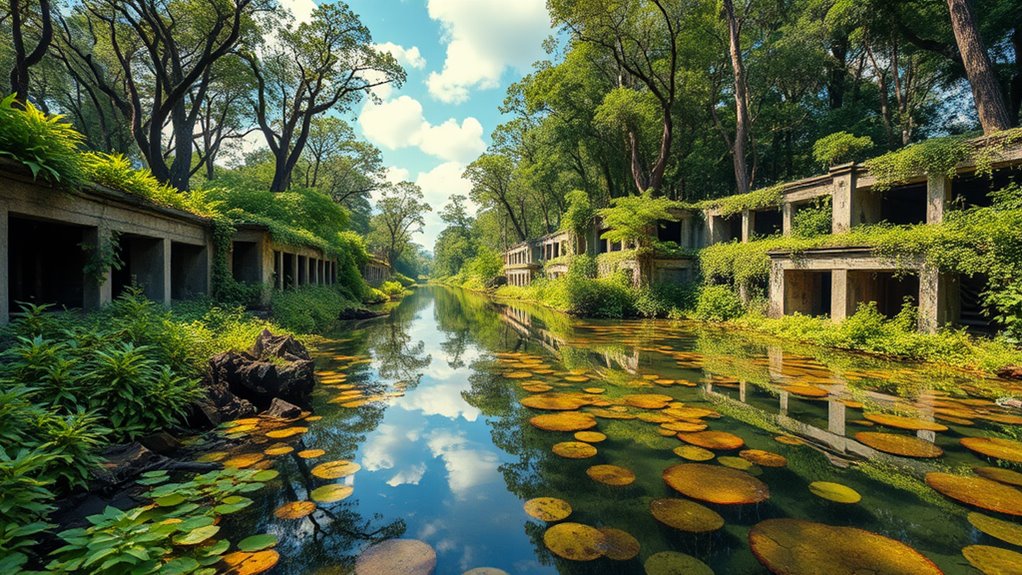
After humans vanish, nature begins a remarkable recovery process that unfolds in various stages. Without human interference, ecosystems start to regain their balance through natural recovery. Forests and grasslands thrive as they regenerate to levels of biodiversity often surpassing those of human-planted areas. Species adapt and evolve in response to the environment's natural pressures, fostering a dynamic interplay among plants and animals.
While natural climate fluctuations persist, they occur at a slower rate without human-induced emissions, allowing ecosystems to stabilize. Over millions of years, you'd witness a gradual increase in diversity and lushness across landscapes. However, it's essential to acknowledge that this recovery isn't instantaneous; it could take between 3 and 7 million years for the planet to regain its pre-extinction species richness. Additionally, the process of recovery highlights the importance of well-informed management that can enhance the effectiveness of natural regeneration in specific areas.
Pollution levels begin to decline as human activities cease. Persistent organic pollutants linger for thousands of years, yet natural degradation processes gradually reduce their toxicity. Meanwhile, the absence of pesticides allows insect populations and other wildlife to rebound.
The ecological restoration processes involve not just the removal of invasive species but also the intricate interplay of chemical transformations and biological interactions that promote a healthier ecosystem.
Monitoring these recovery processes is vital to guarantee they're effective in mitigating risks. Ultimately, as ecosystem dynamics shift and evolve, you'll see the land reclaim its former glory, adapting to new realities and fostering life in ways unimaginable in a human-dominated world.
Changes in Wildlife Populations
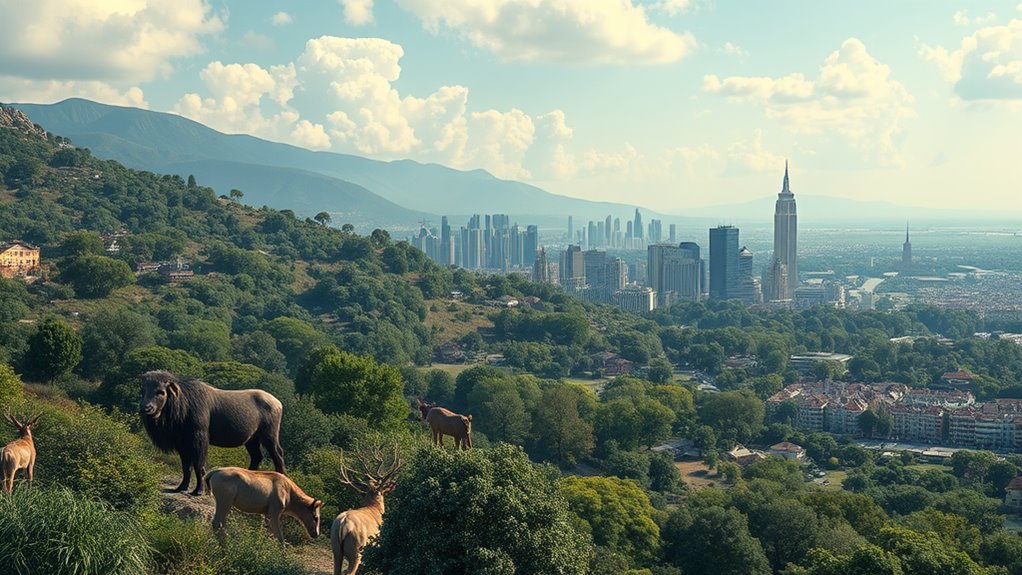
Wildlife populations would undergo dramatic transformations in a world devoid of human presence. Without your influence, ecosystems would flourish, allowing biodiversity to thrive. Indigenous flora and fauna would reclaim their territories, creating diverse habitats teeming with life. Large mammals would likely see a spike in their populations across most continents, leading to shifts in population dynamics as predators and prey adjust to the new balance.
Without artificial barriers, animals would roam freely, altering their migratory patterns and enabling genetic exchanges among species. This liberty would spark wildlife adaptations, as species evolve to better cope with natural environmental pressures. Forests would transform, as the absence of human encroachment facilitates the return of native wildlife, fostering an intricate web of life. Notably, increased human-wildlife overlap would no longer pose a threat, allowing species to thrive without the pressures of habitat loss.
However, domesticated animals like dogs and cats would struggle. They've grown dependent on human provisions, and their survival would be uncertain in a wild landscape. Some might adapt, while others may face decline, affecting ecosystem dynamics and nutrient cycling.
Unchecked growth among certain wildlife could lead to ecological imbalances, creating competition for resources. Scavengers would thrive, playing an essential role in maintaining ecosystem health.
Ultimately, the lack of human management would set the stage for natural selection to favor traits that align with specific habitats, driving wildlife adaptations and ensuring the survival of the fittest.
In this world, you'd witness a rich tapestry of life, where nature reclaims its rightful place, unencumbered by human intervention.
Long-Term Human Legacy
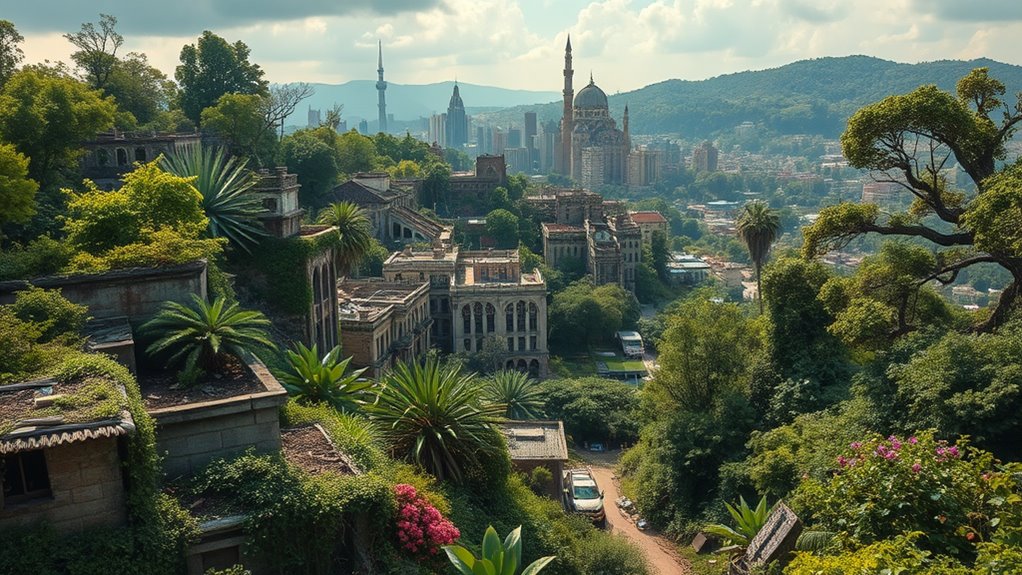
Humanity's mark on the Earth will endure long after your presence fades. The structures you built, from the Great Pyramid of Giza to military installations, can last for millennia, quietly telling your story. These concrete giants, sheltered from the elements, will stand firm against time.
Roads and ruins might eventually succumb to nature, but they'll linger long enough for future generations to ponder your existence. As urban landscapes transform into new ecosystems, the remnants of your civilization will provide a unique window into your past.
Your waste, too, will leave indelible reminders. Massive landfills will rise as hills, preserving human artifacts like worn shoes and broken toys for over a thousand years. Meanwhile, the impact of plastic pollution will echo through the ages, as it hampers wildlife and reshapes ecosystems.
Yet, in time, microbes will adapt, evolving to consume the remnants of your consumption.
Beneath the surface, your subterranean alterations will tell a deeper tale. Mines, tunnels, and storage facilities will persist for millions of years, etched into the Earth's geological record.
Even remnants of underground nuclear tests will remain for future explorers to decipher.
Beyond your planet, technological remnants like the Voyager probes will drift through the cosmos, potentially lasting trillions of years. These artifacts will serve as humanity's final ambassadors, whispering of your existence long after the stars fade.
In this enduring legacy, both physical and technological, you'll leave a complex tapestry that future life will unravel, long after you've disappeared from the face of the Earth.
Cultural Impact of Human Loss
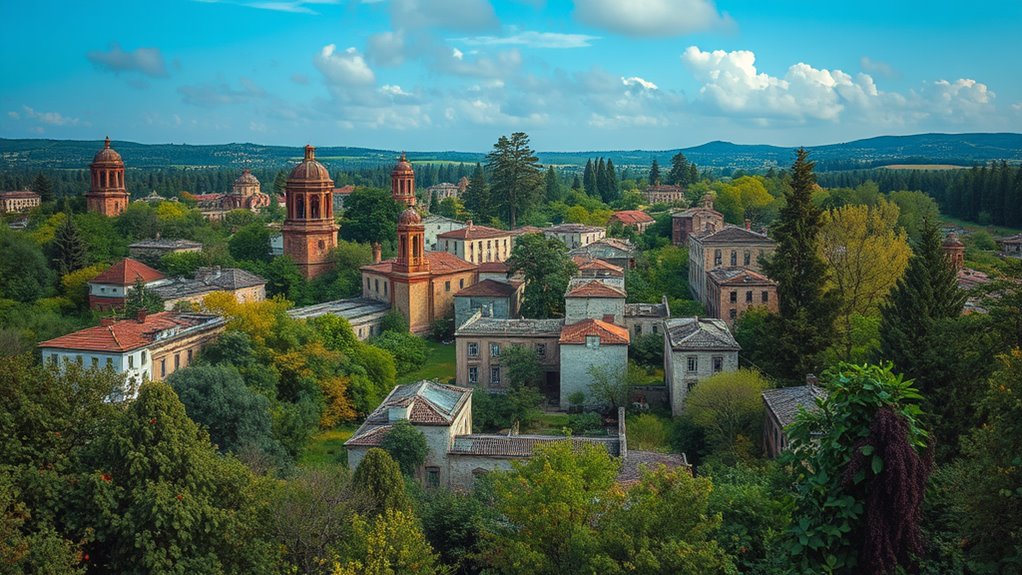
The enduring legacy of human structures and technological artifacts will eventually give way to a world shaped by the absence of cultural diversity. With the loss of communities, we face a stark cultural extinction, leading to a decline in traditional practices and indigenous knowledge. As languages vanish—up to 90% projected by century's end—you'll witness profound language loss that erodes social dynamics and heritage preservation.
Consider the following impacts:
- Cultural Heritage: Without humans, the rich tapestry of literature, art, and music fades into silence, leaving achievements unrecognized and uncelebrated.
- Traditional Knowledge: The wisdom of community elders regarding local ecosystems and species, like the Southern Resident killer whales, vanishes, jeopardizing survival methods and cultural practices.
- Community Resilience: The absence of social structures removes the frameworks that have historically allowed communities to adapt to environmental changes, diminishing their resilience. This could lead to a mass cultural extinction of unique practices that have defined various societies.
- Cultural Adaptation: The loss of diverse cultural traits limits humanity's ability to adapt to new challenges, as unique perspectives and solutions dissipate.
In this world without humans, the once vibrant expressions of culture will decay, and the stories that shaped civilizations will be lost forever.
The repercussions will extend beyond the present; the knowledge and practices that fostered community resilience will vanish, leaving a void that future generations will never know. The cultural landscape will be irrevocably altered, reminding us of the intricate connections we share with our diverse heritage.
Ecological Imbalances and Restorations
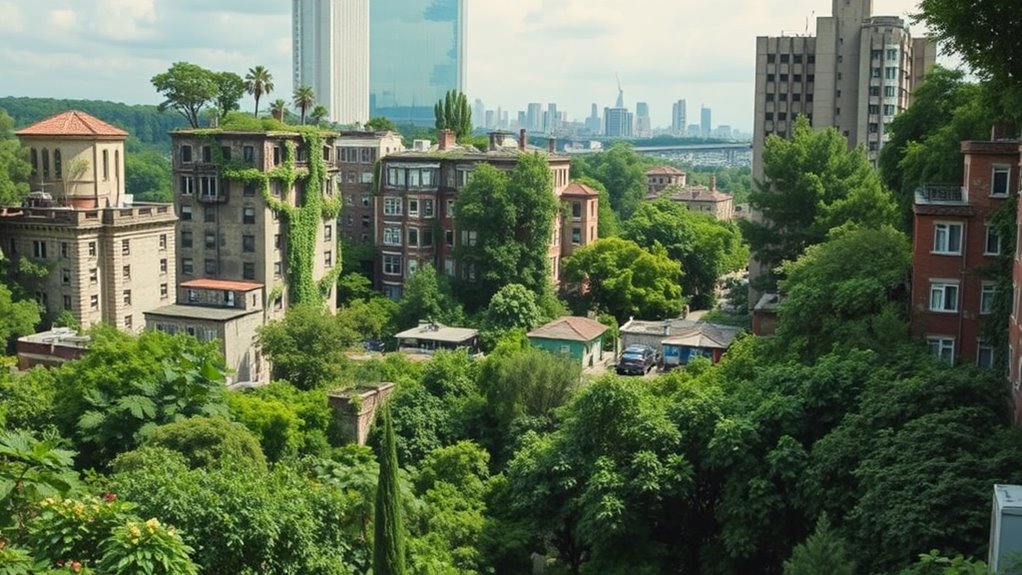
In a world stripped of human presence, ecological imbalances will begin to shift dramatically, giving nature a chance to reclaim its territory. As pollution ceases immediately, air, water, and land will start to heal, allowing ecosystems to flourish.
You'd witness a rapid recovery of insect populations, essential for pollination and food webs, as they thrive without harmful chemicals. Urban areas and fields would become vibrant with vegetation, leading to significant habitat restoration.
Without human interference, keystone species like elephants could return, enhancing biodiversity and stabilizing ecosystems. Their natural behaviors would help shape habitats, demonstrating species resilience in the face of change.
Coral reefs, once suffering from bleaching, might recover if ocean temperatures stabilize, showcasing the ocean's ability to bounce back.
However, the journey won't be without challenges. Plastic waste will linger for thousands of years, impacting wildlife and habitat integrity.
Additionally, the remnants of climate change will continue to influence ecosystems, as greenhouse gases slowly dissipate. You might also see the collapse of industrial infrastructure leading to potential hazards, but nature will gradually mitigate these threats over time.
Ultimately, ecosystems will initiate a long road to recovery. The absence of human-induced pressures will foster a diverse and resilient web of life.
While it'll take millions of years for the planet to regain its full richness, the process of ecological restoration will begin, paving the way for a healthier planet.
Future of Earth's Ecosystems
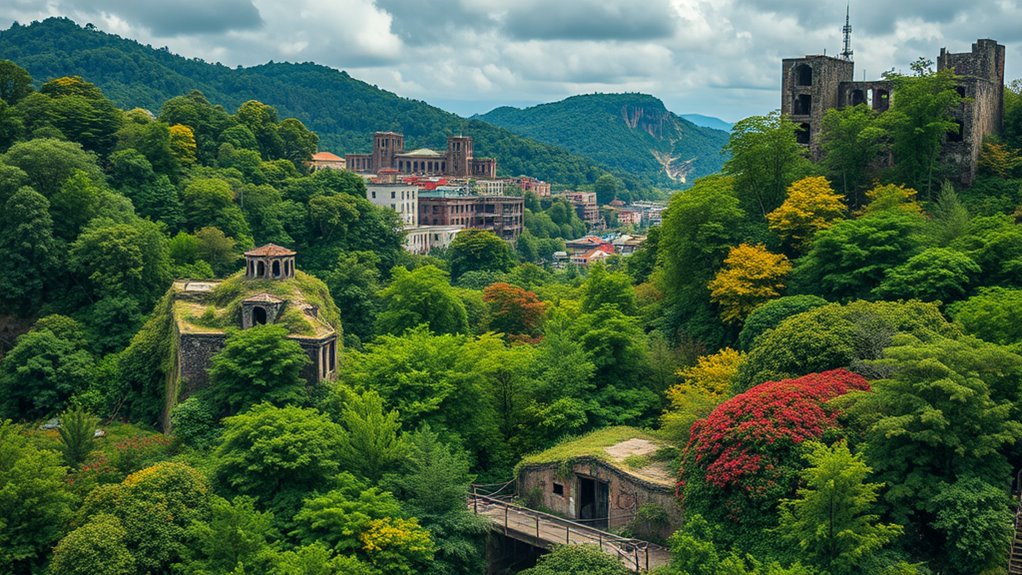
With nature beginning to reclaim its space, the future of Earth's ecosystems will unfold in fascinating ways. As human activities cease, you'll witness remarkable changes that enhance ecosystem resilience and foster species adaptation. The natural world will thrive, creating dynamic environments filled with biodiversity.
Here are four key transformations you can expect:
- Urban Rewilding: Cities will transform into lush habitats, with vegetation overtaking buildings and roads, providing homes for wildlife and increasing biodiversity.
- Insect Revival: Without pesticides, insect populations will rebound, promoting healthier plant life and supporting various species that rely on these insects for survival.
- Wildlife Population Growth: Animal populations will flourish without human interference, leading to new dynamics within ecosystems that could create both opportunities and challenges for survival.
- Nutrient Cycling: Natural processes will restore soil quality and nutrient distribution, enhancing productivity across ecosystems and allowing diverse plant and animal species to thrive.
As these changes unfold, species will adapt to new challenges and opportunities, leading to evolutionary shifts over time. The absence of human-induced environmental pressures will allow ecosystems to recover and evolve naturally.
While climate fluctuations may still occur due to natural processes, the overall reduction in human impacts will lead to a cooler planet, giving ecosystems the chance to flourish.
In this new world, the intricate dance of life will continue, showcasing nature's resilience and capability to adapt and thrive.
Frequently Asked Questions
How Would Human Absence Affect Climate Change in the Short Term?
In the short term, your absence would lead to an immediate halt in carbon emissions, stabilizing the atmosphere.
While existing CO2 would still contribute to warming for a few decades, natural processes would slowly begin ecological restoration.
You'd notice that weather patterns might stabilize without human influence, and ecosystems could start recovering, absorbing excess CO2.
This shift would create a healthier environment, allowing biodiversity to flourish as pollution and deforestation cease.
What Species Might Thrive First After Humans Disappear?
When humans disappear, you might see octopuses and small fish thriving first.
Octopuses, with their intelligence and adaptability, could exploit new ecological niches.
Meanwhile, small fish and invertebrates, benefiting from fast reproduction, would likely fill gaps left by larger species.
Invasive species could also emerge, taking advantage of the changed environment.
Social insects like ants may flourish too, managing ecosystems effectively and ensuring their survival in the absence of human influence.
How Would Human-Made Structures Change Over Time?
Imagine urban decay sweeping over once-thriving cities like a giant, unstoppable wave.
As you watch, human-made structures crumble, overtaken by relentless nature. Roads erode, buildings sag, and wildlife reclamation takes hold, transforming neighborhoods into lush forests.
Without your maintenance, even the sturdiest materials can't withstand the elements forever.
Over decades, the landscape shifts dramatically, turning concrete jungles into vibrant ecosystems, where nature reclaims its territory and thrives in the absence of humanity.
What Would Happen to Pets Left Behind by Humans?
If you think about pets left behind, their survival hinges on adaptation strategies.
Domesticated species like dogs could tap into their instincts, forming feral populations that learn to forage and hunt. As they adjust, their behavior shifts to prioritize survival, competing with other animals for resources.
This ecological impact would reshape local environments, with only the most adaptable pets thriving. Over time, you'd see a transformation in their traits and behaviors, reflecting their new reality.
How Quickly Could New Ecosystems Establish Without Human Interference?
Imagine walking through a once-bustling city, now eerily silent.
Within mere weeks, nature starts reclaiming the space. You witness natural succession at work, as fast-growing plants burst through cracks, creating vibrant ecosystems.
Over time, biodiversity recovery accelerates, allowing endangered species to flourish in their newfound habitats.
As years roll on, you see forests regrow and wildlife returning, each moment reminding you of nature's resilience and ability to thrive without human interference.
